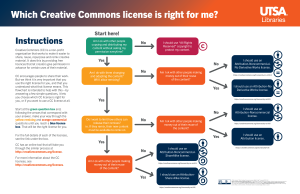14 Attributing
Best Practice Attribution
To provide credit to work you are re-using, always include these 4 components when possible:
T= Title
A=Author (provide link)
S=Source (provide link)
L=License (link to the CC license deed)
Each element is needed in order to ensure that you always give credit to original authors for their work. If you do not have all of the information, do the best you can with the information that is provided. Version 4.0 of licenses does not require you users to include the title of the original work. However, it is best practice to include the title anyway if it is provided.
Example

Open Attribution Builder: Attribution tool from Open Washington that generates attributions for Creative Commons licensed material.
Derivative Attribution
If your work is based on someone else’s work-a modification or adaptation-communicate this clearly and attribute the original creator of the work. It is also important to provide a link to the original work and to the license of that original work.
Example: Attributing Derivative Works

Remixing Best Practices
When re-mixing, you must:
- Clearly identify for users who created which parts of the work
- Identify the terms under which any given work, or part of a work, can be used.
- Provide information about works you used to create your new work or incorporated into your work
“The Saylor MA121: Introduction to Statistics course, below, is a great example of providing a Course Terms of Use: defining what constitutes the “course” and providing information about the sources used to create the course, along with each source’s respective license and original version.”
Attribution
Media Attributions
- Earth 2009 © Kevin M. Gill is licensed under a CC BY (Attribution) license
- Which Creative Commons License is Right for Me?

